By Leen Randell
Updated: Jul 19, 2024
10 Best Herbal Creams For Menstrual Cramps
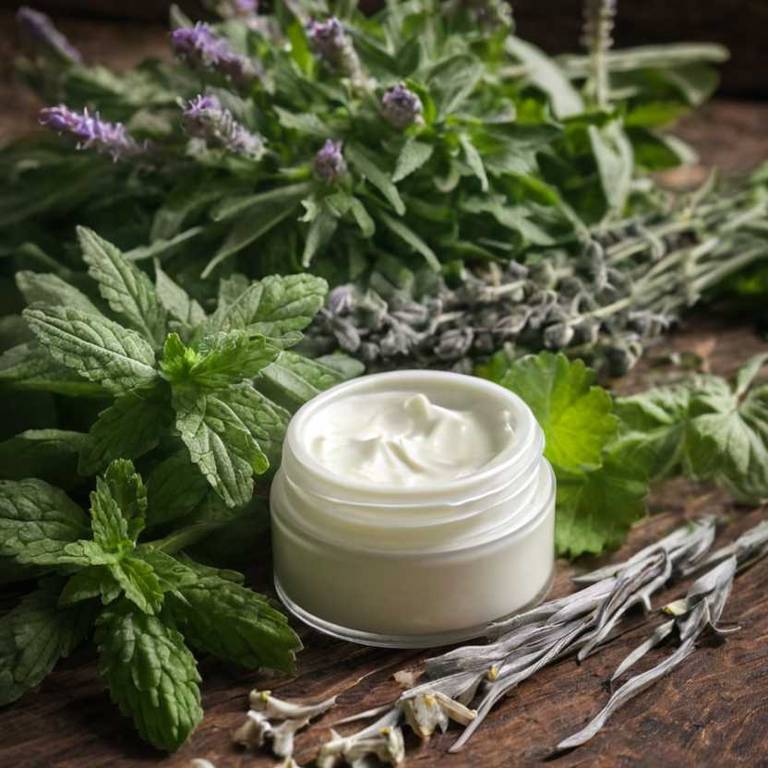
Herbal creams for menstrual cramps are topical creams infused with natural herbs and essential oils that help alleviate menstrual pain and discomfort.
They work by reducing inflammation and relaxing the uterine muscles, providing quick relief from cramps. Examples include creams containing ginger, turmeric, and peppermint, which have anti-inflammatory properties.
By using these creams, women can improve their quality of life, reducing the need for pain medication and allowing them to continue their daily activities with ease.
The following article describes in detail the most important creams for menstrual cramps, including medicinal properties, parts of herbs to use, and recipes for preparations.
- 1. Salix alba
- 2. Viburnum opulus
- 3. Rosa rugosa
- 4. Melissa officinalis
- 5. Glycyrrhiza glabra
- 6. Calendula officinalis
- 7. Citrus x aurantium
- 8. Lavandula angustifolia
- 9. Hypericum perforatum
- 10. Artemisia absinthium
- What is the best combination of herbal creams to use for menstrual cramps?
- What ailments similar to menstrual cramps are treated with herbal creams?
1. Salix alba
Salix alba, also known as white willow, creams helps with menstrual cramps because of its unique combination of salicin and other natural compounds.
Salicin is a natural pain-reliever that works similarly to aspirin, reducing inflammation and blocking pain pathways in the body. As it is absorbed through the skin, the salicin in Salix alba creams is able to target the root cause of menstrual cramps, providing fast and effective relief from painful periods.
This makes it a popular natural remedy for menstrual cramp relief.
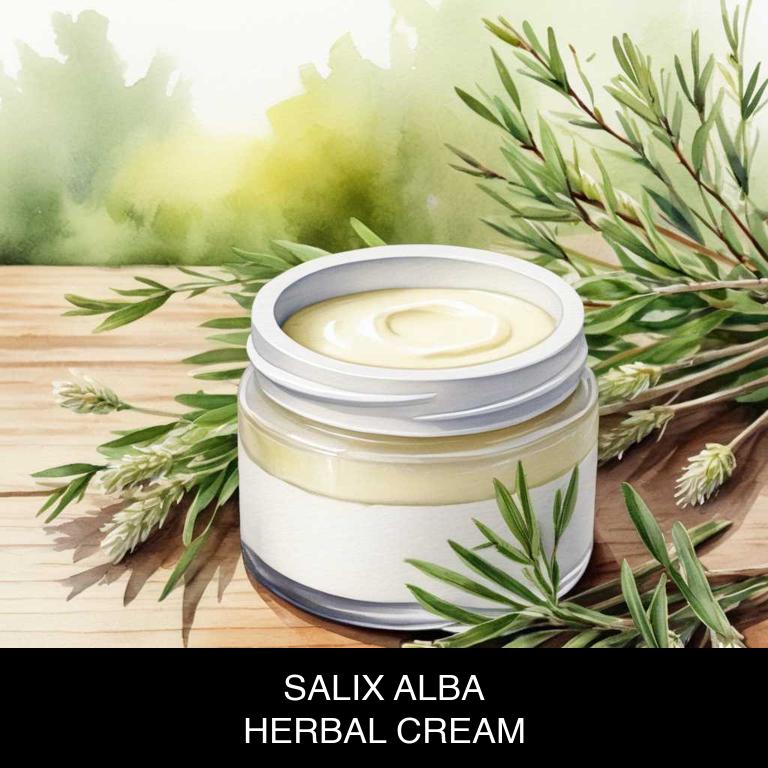
Medicinal Constituents
The list below shows the primary medicinal constituents in Salix alba creams that help with menstrual cramps.
- Salicin: Salicin is a phenolic compound found in Salix alba that acts as a natural pain reliever and anti-inflammatory agent, helping to alleviate menstrual cramps by reducing prostaglandins' production, which cause pain and inflammation.
- Flavonoids: Quercetin is a flavonoid in Salix alba that exhibits anti-inflammatory and antioxidant properties, which help to reduce menstrual cramp severity by inhibiting the production of prostaglandins and other inflammatory mediators.
- Triterpenoids: Salicortin, a triterpenoid in Salix alba, has been found to have anti-inflammatory and analgesic effects, which contribute to the relief of menstrual cramps by reducing inflammation and pain in the uterus.
Parts Used
The list below shows the primary parts of white willow used to make creams for menstrual cramps.
- Barks: Its barks are used due to their anti-inflammatory properties, which help in reducing pain and discomfort associated with menstrual cramps.
- Leaves: The leaves are used because they contain salicin, a compound similar to aspirin, which has analgesic and anti-inflammatory properties that help alleviate menstrual cramp pain.
- Roots: The roots of Salix alba are used for their medicinal properties, including anti-inflammatory and analgesic effects, which help to soothe menstrual cramp pain and reduce inflammation.
Quick Recipe
The following recipe gives a procedure to make a basic white willow for menstrual cramps.
- Harvest 100g of dried salix alba bark and clean it thoroughly to remove any debris or impurities.
- Combine the cleaned salix alba bark with 500ml of carrier oil in a double boiler to infuse for 2 hours.
- Strain the infused mixture through a cheesecloth to separate the oil from the plant material in 30 minutes.
- Mix 50g of beeswax with 100g of cocoa butter and heat the mixture in a double boiler until melted in 20 minutes.
- Combine the infused oil with the melted wax and butter mixture and stir well to form a smooth cream in 10 minutes.
2. Viburnum opulus
Viburnum opulus, also known as guelder rose, creams helps with menstrual cramps because of its analgesic and anti-inflammatory properties.
The cream is derived from the plant's berries, which contain salicin, a compound similar to aspirin. Salicin helps to reduce prostaglandins, hormone-like substances that cause pain and inflammation during menstruation.
By applying the cream topically, it can provide localized relief from cramps, allowing women to manage their symptoms more effectively and maintain their daily activities without discomfort.
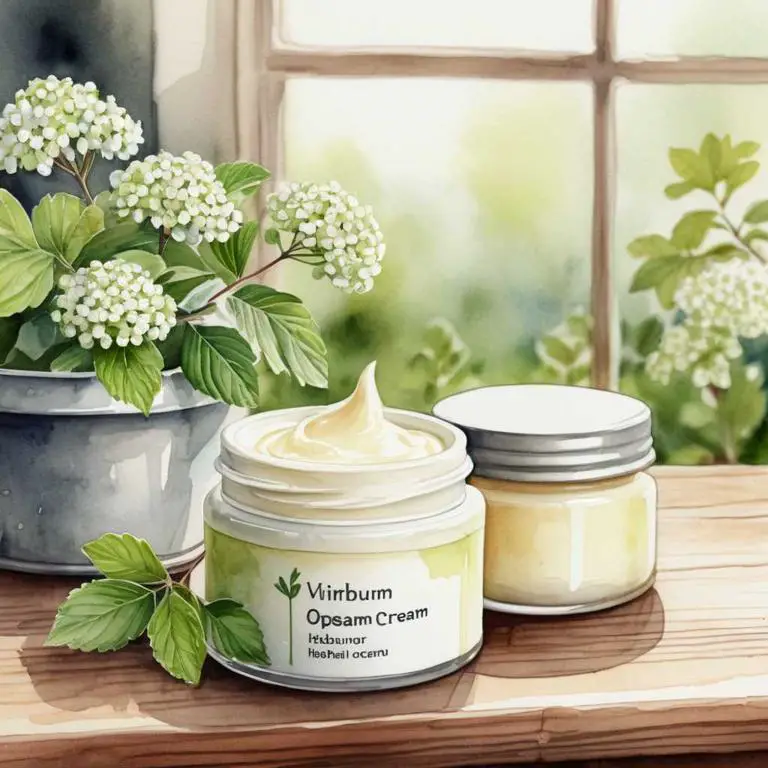
Medicinal Constituents
The list below shows the primary medicinal constituents in Viburnum opulus creams that help with menstrual cramps.
- Oleanolic acid: This triterpenoid compound helps with menstrual cramps by inhibiting the production of prostaglandins, which are hormone-like substances that cause uterine contractions and pain.
- Viburnin: This flavonoid glycoside has anti-inflammatory and analgesic properties, which help to reduce pain and inflammation associated with menstrual cramps.
- Salicin: This phenolic glycoside is a natural analgesic and anti-inflammatory compound that helps to reduce pain and inflammation caused by menstrual cramps, similar to aspirin.
Parts Used
The list below shows the primary parts of guelder rose used to make creams for menstrual cramps.
- Barks: Its barks are used due to their antispasmodic and anti-inflammatory properties.
- Leaves: The leaves of Viburnum opulus are used for their antispasmodic and analgesic properties, which help to relieve menstrual cramps.
- Flowers: The flowers of Viburnum opulus are used due to their estrogenic properties, which can help regulate menstrual cycles and alleviate associated cramps.
Quick Recipe
The following recipe gives a procedure to make a basic guelder rose for menstrual cramps.
- Harvest fresh or dried viburnum opulus flowers and leaves in the morning when they are at their most fragrant.
- Combine 1 part dried viburnum opulus with 2 parts coconut oil in a clean glass jar.
- Steep the mixture in a warm water bath for 2-3 hours then strain it through a cheesecloth.
- Mix the infused oil with 1/2 cup beeswax and 1/4 cup shea butter in a double boiler.
- Whisk the mixture until it thickens then pour it into tin containers and let them cool completely.
3. Rosa rugosa
Rosa rugosa, also known as beach rose, creams helps with menstrual cramps because of its anti-inflammatory and antioxidant properties.
The cream, typically made by infusing Rosa rugosa petals in a carrier oil, is rich in flavonoids and phenolic acids that work to soothe and calm the uterus, reducing cramping and discomfort associated with menstrual cycles.
The natural compounds also help to relax the muscles and promote a sense of calm, providing relief from menstrual cramps and promoting overall well-being.
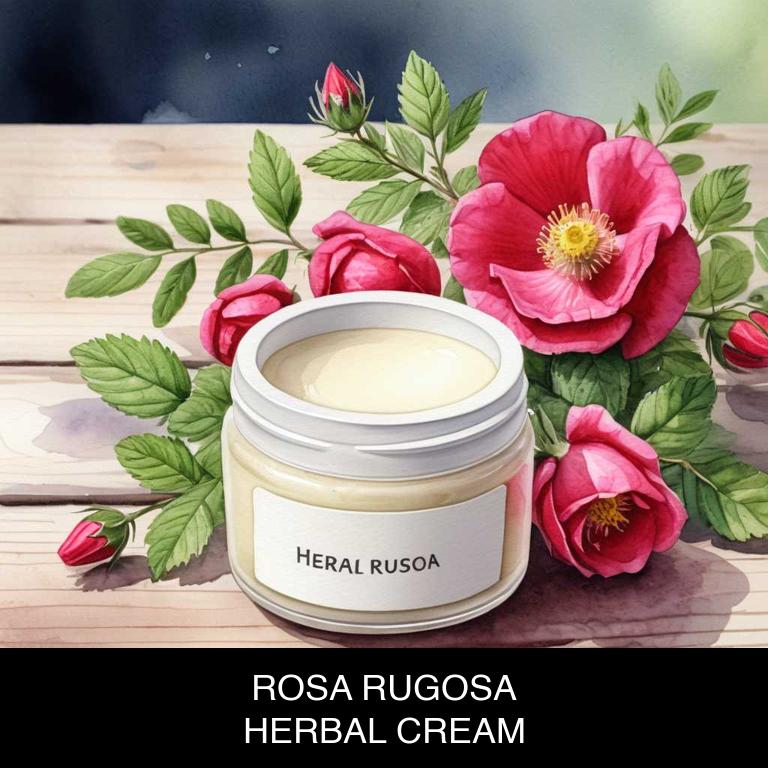
Medicinal Constituents
The list below shows the primary medicinal constituents in Rosa rugosa creams that help with menstrual cramps.
- Rosmarinic acid: This phenolic compound has anti-inflammatory and analgesic properties, which help reduce pain and inflammation associated with menstrual cramps.
- Rosavin: A phenolic glycoside found in Rosa rugosa, rosavin has anti-inflammatory and antioxidant effects that may help alleviate menstrual cramp symptoms.
- Rosa rugosa flavonoids: These flavonoids, including quercetin and kaempferol, have anti-inflammatory and antioxidant properties that may help reduce menstrual cramp pain and alleviate symptoms associated with PMS.
Parts Used
The list below shows the primary parts of beach rose used to make creams for menstrual cramps.
- Leaves: Used for their anti-inflammatory properties, which help to reduce pain and discomfort.
- Roots: Employed for their sedative and anti-spasmodic effects, which help to calm the uterus and alleviate cramps.
- Buds: Utilized for their antiseptic and anti-inflammatory properties, which help to soothe and protect the uterine lining.
Quick Recipe
The following recipe gives a procedure to make a basic beach rose for menstrual cramps.
- Gather 10 dried rosa rugosa flowers and 5 grams of sweet almond oil in a clean glass container.
- Infuse the rosa rugosa flowers in 50 milliliters of sweet almond oil for 2 weeks in a cool dark place.
- Strain the infused oil through a cheesecloth into another glass container and discard the solids.
- Combine 5 grams of beeswax and 10 grams of shea butter in a double boiler and melt them over low heat.
- Mix the melted beeswax and shea butter with the infused oil and pour the mixture into small glass jars to cool.
4. Melissa officinalis
Melissa officinalis, also known as lemon balm, creams helps with menstrual cramps because of its analgesic and antispasmodic properties.
The compounds present in Melissa officinalis, such as rosmarinic acid and citral, have a calming effect on the uterus, reducing muscle spasms and cramping. This natural remedy also helps to relax the body, reducing stress and anxiety associated with menstrual cramps.
As a result, Melissa officinalis creams provide a soothing and comforting relief for women experiencing menstrual discomfort.
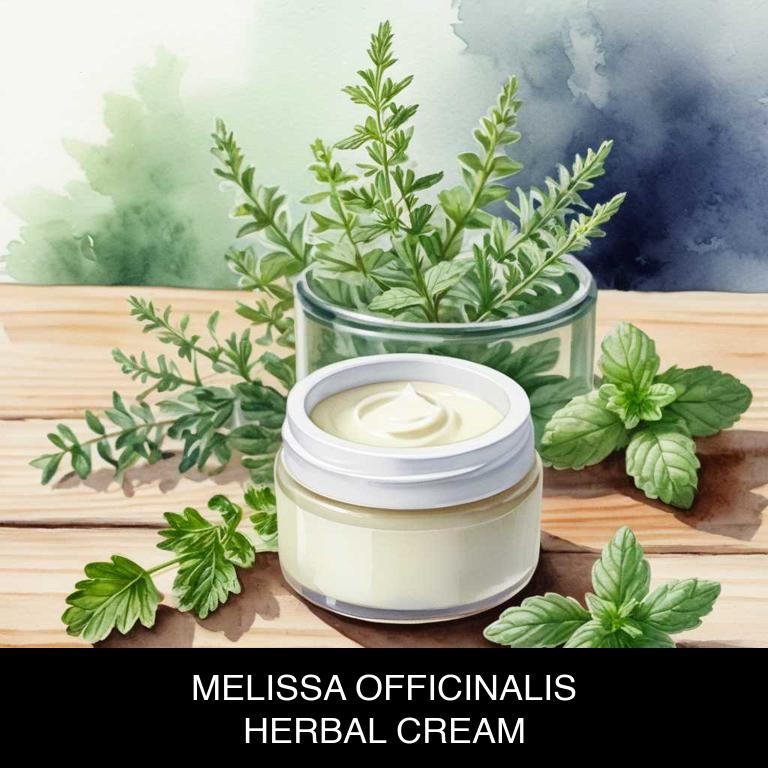
Medicinal Constituents
The list below shows the primary medicinal constituents in Melissa officinalis creams that help with menstrual cramps.
- Rosmarinic acid: A phenolic compound that helps alleviate menstrual cramps by acting as an anti-inflammatory agent and reducing prostaglandin production, which is associated with pain and inflammation.
- Linalool: A terpene that exhibits analgesic and anti-inflammatory properties, helping to relieve menstrual cramp pain by reducing inflammation and modulating pain pathways in the body.
- Luteolin: A flavonoid with anti-inflammatory and antioxidant properties that helps in reducing menstrual cramp pain by inhibiting the production of pro-inflammatory enzymes and reducing oxidative stress.
Parts Used
The list below shows the primary parts of lemon balm used to make creams for menstrual cramps.
- Leaves: Known for their anti-inflammatory and soothing properties, which can help to ease menstrual cramp discomfort.
- Stems: Often used in herbal remedies for their antispasmodic properties, which can help to relax the uterine muscles and reduce cramping.
- Roots: Traditionally used for their analgesic and anti-inflammatory properties, which can help to alleviate pain and discomfort associated with menstrual cramps.
Quick Recipe
The following recipe gives a procedure to make a basic lemon balm for menstrual cramps.
- Harvest 2 cups of melissa leaves in the early morning when the dew is still present on the plant.
- Steep 1 cup of melissa leaves in 2 cups of water for 10-15 minutes to create a tea.
- Strain the tea through a cheesecloth and squeeze out as much liquid as possible.
- Combine 1/4 cup of beeswax and 1/4 cup of coconut oil in a double boiler and melt the mixture.
- Mix 2 tablespoons of the strained melissa tea with the melted wax and oil mixture to create a cream base.
5. Glycyrrhiza glabra
Glycyrrhiza glabra, also known as licorice, creams helps with menstrual cramps because of its anti-inflammatory and antispasmodic properties.
The active compound, glycyrrhizin, has been shown to relax uterine muscles, reducing cramping and discomfort associated with menstruation. Additionally, licorice creams' soothing and moisturizing effects can help calm the skin, reducing redness and irritation that can accompany menstrual cramps.
As a result, many women find relief from menstrual cramps with the use of herbal Glycyrrhiza glabra creams.

Medicinal Constituents
The list below shows the primary medicinal constituents in Glycyrrhiza glabra creams that help with menstrual cramps.
- Glycyrrhizin: This triterpenoid saponin has anti-inflammatory properties, which help to reduce pain and discomfort associated with menstrual cramps by inhibiting the production of prostaglandins.
- Licoricidin: A phenolic compound with anti-inflammatory and analgesic properties, licoricidin helps to alleviate menstrual cramps by blocking the release of pain-causing chemicals in the body.
- Licopyrones: A group of flavonoids and phenolic compounds, licopyrones have anti-inflammatory and antioxidant properties, which contribute to their analgesic and anti-spasmodic effects, helping to reduce menstrual cramp severity.
Parts Used
The list below shows the primary parts of licorice used to make creams for menstrual cramps.
- Roots: They are used to make creams for menstrual cramps due to their high glycyrrhizin content, which has anti-inflammatory and pain-relieving properties.
- Flowers: They are used to make creams for menstrual cramps due to their estrogenic and anti-inflammatory properties, which help alleviate cramps and other symptoms associated with PMS.
- Barks: They are used to make creams for menstrual cramps due to their anti-inflammatory and antioxidant properties, which help reduce pain and inflammation associated with menstrual cramps.
Quick Recipe
The following recipe gives a procedure to make a basic licorice for menstrual cramps.
- Harvest 10 grams of dried glycyrrhiza glabra roots and grind them into a fine powder using a mortar and pestle for 5 minutes.
- Combine the ground glycyrrhiza glabra powder with 50 grams of vegetable oil in a double boiler over low heat for 30 minutes.
- Stir the mixture for 10 minutes and add 10 grams of beeswax to the double boiler for an additional 10 minutes.
- Remove the double boiler from the heat source and let the mixture cool to 40°c for 20 minutes.
- Whip the cooled mixture into a smooth cream using a hand mixer for 5 minutes.
6. Calendula officinalis
Calendula officinalis, also known as pot marigold, creams helps with menstrual cramps because of its anti-inflammatory and antispasmodic properties.
The cream's active compounds, such as triterpenoids and saponins, work to relax the uterine muscles and reduce inflammation, thereby easing the severity of menstrual cramps. Additionally, calendula's natural analgesic and soothing properties help to calm the discomfort associated with menstrual pain, providing relief and promoting a sense of well-being during this time.
Its natural benefits make it a popular alternative remedy for menstrual cramp relief.

Medicinal Constituents
The list below shows the primary medicinal constituents in Calendula officinalis creams that help with menstrual cramps.
- Triterpenoids: These compounds have anti-inflammatory properties, which can help reduce pain and discomfort associated with menstrual cramps.
- Phenolic acids: Phenolic acids, particularly caffeic acid and ferulic acid, have anti-spasmodic and anti-inflammatory effects, which can help ease menstrual cramp pain and reduce inflammation in the uterus.
- Carotenoids: Beta-carotene has antioxidant properties, which can help reduce oxidative stress and inflammation in the body, potentially alleviating menstrual cramp symptoms.
Parts Used
The list below shows the primary parts of pot marigold used to make creams for menstrual cramps.
- Flowers: Used due to their anti-inflammatory and antispasmodic properties, which help to soothe menstrual cramp pain.
- Leaves: Utilized for their antispasmodic and anti-inflammatory effects, which help to reduce menstrual cramp severity.
- Seeds: Employed due to their reported emmenagogic properties, which help to regulate menstrual cycles and alleviate cramp symptoms.
Quick Recipe
The following recipe gives a procedure to make a basic pot marigold for menstrual cramps.
- Harvest 1 cup of calendula officinalis flowers in their full bloom and dry them completely in a warm place for 2 weeks.
- Infuse 2 tablespoons of dried flowers in 2 cups of carrier oil such as sweet almond oil for 4 weeks.
- Strain the infused oil through a cheesecloth into a clean glass container and discard the solids.
- Mix 1 tablespoon of the infused oil with 8 ounces of a base cream such as beeswax and coconut oil.
- Whip the mixture until it thickens and transfer it to a clean glass jar for storage.
7. Citrus x aurantium
Citrus x aurantium, also known as bitter orange, creams helps with menstrual cramps because of its stimulating and warming properties.
The compounds found in Citrus x aurantium, such as synephrine and hesperidin, have been shown to relax the uterine muscles, reducing cramping and discomfort. Additionally, the cream's anti-inflammatory properties may help to soothe and calm the body, providing relief from menstrual cramps and other associated symptoms.
This natural remedy offers a potential alternative to conventional pain management options.
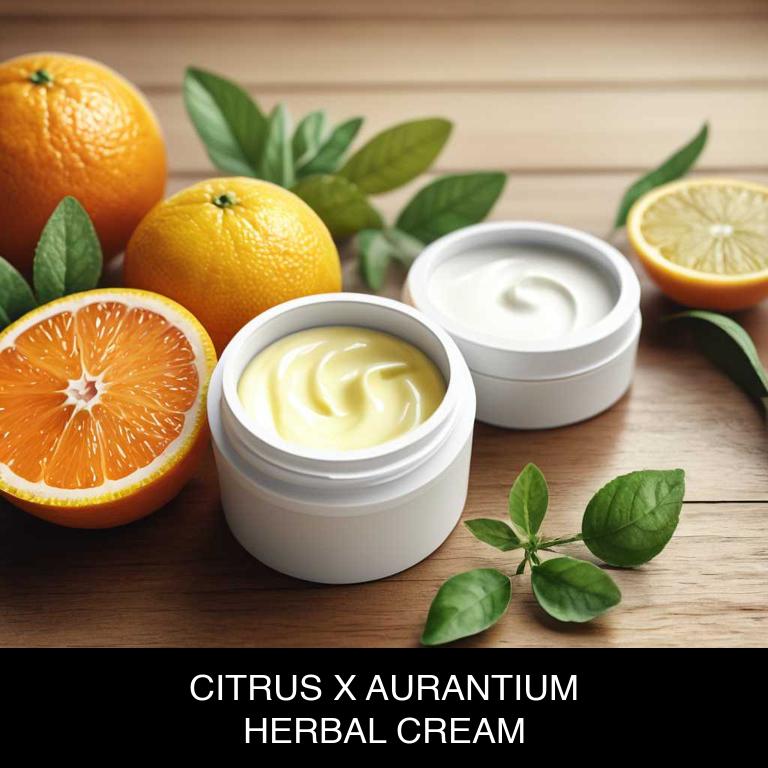
Medicinal Constituents
The list below shows the primary medicinal constituents in Citrus x aurantium creams that help with menstrual cramps.
- Citral: Citral is a terpene that has anti-inflammatory and analgesic properties, which can help to reduce pain and discomfort associated with menstrual cramps.
- Neroli oil: These terpenes in neroli oil have a sedative effect, which can help to reduce anxiety and promote relaxation, potentially alleviating menstrual cramp pain.
- Flavonoids: Flavonoids in Citrus x aurantium have vasoconstrictor properties, which can help to reduce blood flow to the uterus and alleviate menstrual cramp pain.
Parts Used
The list below shows the primary parts of bitter orange used to make creams for menstrual cramps.
- Peel (fruits): The peel of the fruits is often used to make creams due to its high concentration of essential oils, particularly bergamot oil, which has anti-inflammatory and analgesic properties.
- Seeds: Citrus x aurantium seeds are used to make creams due to their high content of cold-pressed seed oil, which contains compounds like limonene and linalool that have pain-relieving and anti-inflammatory effects.
- Flowers: The flowers of Citrus x aurantium are used to make creams due to their high content of essential oils, including bergamot oil, which has been traditionally used to alleviate menstrual cramps and other pain symptoms.
Quick Recipe
The following recipe gives a procedure to make a basic bitter orange for menstrual cramps.
- Harvest 20g of citrus x aurantium peel and clean it under cold running water for 5 minutes.
- Combine the citrus x aurantium peel with 50g of carrier oil in a double boiler.
- Steep the mixture for 2 hours at 50-60°c to infuse the oil.
- Strain the mixture through a cheesecloth and discard the solids for 10 minutes.
- Blend the infused oil with 5g of beeswax and 5g of shea butter for 5 minutes.
8. Lavandula angustifolia
Lavandula angustifolia, also known as English lavender, creams helps with menstrual cramps because of its natural anti-inflammatory and analgesic properties.
The cream's active compounds, such as linalool and linalyl acetate, work together to relax muscles, reduce spasms, and ease pain. Additionally, lavender's calming effects on the nervous system can help alleviate anxiety and stress, common symptoms associated with menstrual cramps.
This natural remedy promotes a sense of relaxation and comfort, providing relief from menstrual discomfort.

Medicinal Constituents
The list below shows the primary medicinal constituents in Lavandula angustifolia creams that help with menstrual cramps.
- Linalool: A terpene that helps relax the uterine muscles, reducing cramping and discomfort associated with menstrual cramps.
- Linalyl acetate: A terpene that has analgesic and anti-inflammatory properties, helping to alleviate pain and reduce inflammation caused by menstrual cramps.
- Rosmarinic acid: A phenolic compound that acts as an antioxidant, anti-inflammatory, and analgesic agent, helping to reduce pain and inflammation, and promoting relaxation.
Parts Used
The list below shows the primary parts of english lavender used to make creams for menstrual cramps.
- Flowers: They are used due to their calming and anti-inflammatory properties, which help to soothe menstrual cramps and reduce pain.
- Leaves: They are used for their analgesic and anti-inflammatory properties, which provide relief from menstrual cramps and other symptoms associated with PMS.
- Buds: They are used due to their ability to reduce inflammation and promote relaxation, making them effective in alleviating menstrual cramp pain.
Quick Recipe
The following recipe gives a procedure to make a basic english lavender for menstrual cramps.
- Harvest 100g of dried lavandula angustifolia flowers for maximum potency and fragrance at peak bloom time.
- Combine the dried flowers with 500ml of sweet almond oil in a heat-proof glass container for infusion.
- Place the container in a double boiler and gently heat the mixture for 2 hours at 45°c to 55°c.
- Strain the infused oil through a cheesecloth or fine mesh to remove the dried flowers in 30 minutes.
- Mix 100g of beeswax and 100g of shea butter with 200ml of the infused oil in a double boiler.
9. Hypericum perforatum
Hypericum perforatum, also known as St John's Wort, creams helps with menstrual cramps because it contains active compounds like hyperforin and hypericin, which have anti-inflammatory and analgesic properties.
These compounds work together to reduce pain and discomfort associated with menstrual cramps. The cream's ability to penetrate deep into the skin allows for direct absorption of these active compounds, providing fast and effective relief from menstrual cramps.
This natural remedy can be a soothing alternative for women seeking relief from period pain.

Medicinal Constituents
The list below shows the primary medicinal constituents in Hypericum perforatum creams that help with menstrual cramps.
- Hyperforin: This phenolic compound has anti-inflammatory and analgesic properties, which help reduce pain and discomfort associated with menstrual cramps.
- Hypericin: This phenolic compound has a sedative effect, which can help relax the uterine muscles and reduce spasms that cause menstrual cramps.
- N-feruloyltyramine: This alkaloid compound has analgesic and anti-inflammatory properties, which can help alleviate pain and reduce inflammation that contribute to menstrual cramps.
Parts Used
The list below shows the primary parts of st john's wort used to make creams for menstrual cramps.
- Leaves: Used due to their high content of flavonoids and tannins, which have anti-inflammatory and antispasmodic properties.
- Flowers: Used for their ability to reduce inflammation and ease pain, thanks to their high concentration of flavonoids and other bioactive compounds.
- Roots: Used due to their rich content of hypericin and hyperforin, which have anti-inflammatory and antispasmodic properties that can help alleviate menstrual cramps.
Quick Recipe
The following recipe gives a procedure to make a basic st john's wort for menstrual cramps.
- Extract 30 grams of dried hypericum perforatum flowers in a 1:5 ratio with a neutral solvent like glycerin for 2 weeks.
- Filter the solvent extract to remove plant material and obtain a clear liquid extract.
- Mix 30 grams of the liquid extract with 90 grams of base oil like coconut oil in a double boiler.
- Heat the mixture to 60-70 degrees celsius for 30 minutes to emulsify the ingredients and facilitate absorption.
- Allow the mixture to cool and set before transferring it to a container for storage and use.
10. Artemisia absinthium
Artemisia absinthium, also known as wormwood, creams helps with menstrual cramps because of its unique combination of sesquiterpene lactones and other bioactive compounds.
These compounds have natural anti-inflammatory and analgesic properties, which help to reduce pain and discomfort associated with menstrual cramps.
Additionally, wormwood's ability to relax uterine muscles and improve blood flow may also contribute to its effectiveness in alleviating menstrual cramps, providing relief to women who suffer from this common symptom.
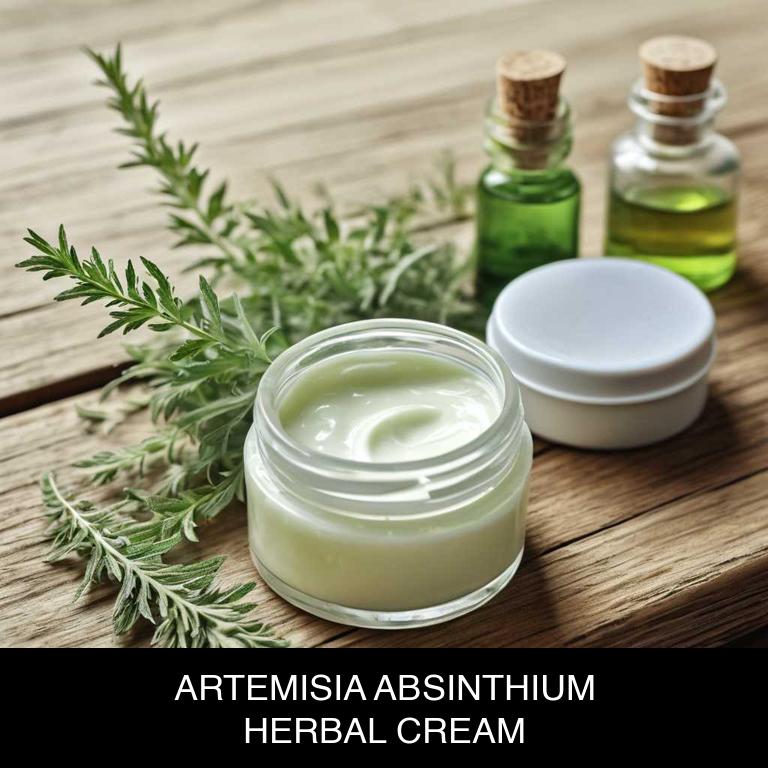
Medicinal Constituents
The list below shows the primary medicinal constituents in Artemisia absinthium creams that help with menstrual cramps.
- Thujone: Thujone is a terpene that acts as a natural anti-inflammatory and analgesic, helping to reduce pain and discomfort associated with menstrual cramps.
- Bornyl acetate: Bornyl acetate is a terpene that has anti-inflammatory and antispasmodic properties, which can help relax the uterine muscles and alleviate menstrual cramp symptoms.
- Tannins: Tannins are phenolic compounds that have anti-inflammatory and astringent properties, which may help reduce inflammation and relax the uterine muscles, providing relief from menstrual cramps.
Parts Used
The list below shows the primary parts of wormwood used to make creams for menstrual cramps.
- Leaves: They contain thujone, a compound that may help to relax the uterine muscles and alleviate cramps.
- Stems: They are rich in sesquiterpene lactones, which have anti-inflammatory properties that may help to reduce pain and discomfort.
- Roots: They contain sesquiterpene lactones and volatile oils, which may help to relax the uterine muscles and provide anti-inflammatory effects.
Quick Recipe
The following recipe gives a procedure to make a basic wormwood for menstrual cramps.
- Harvest 20-30 grams of dried artemisia absinthium leaves and flowers and clean them thoroughly with a fine-mesh sieve.
- Infuse 20 grams of the cleaned herbs in 200 milliliters of neutral oil such as jojoba oil for 2-4 weeks.
- Strain the infused oil through a cheesecloth and discard the solids then transfer the oil to a clean container.
- Mix 10 grams of beeswax and 20 grams of shea butter into the infused oil and heat the mixture gently until the wax melts.
- Allow the mixture to cool and thicken before transferring it to a tube or jar and labeling it accordingly.
What is the best combination of herbal creams to use for menstrual cramps?
The best combination of herbal creams that help with menstrual cramps is a blend of clary sage, ginger, and chamomile.
Clary sage soothes muscle tension, while ginger reduces inflammation and ginger has natural anti-inflammatory properties. Chamomile calms the mind and body, promoting relaxation and reducing stress. Applying a combination cream containing these herbs can provide relief from menstrual cramps, promoting a sense of calm and comfort during this time.
This natural combination can be especially beneficial for those experiencing severe or debilitating menstrual cramps.
What ailments similar to menstrual cramps are treated with herbal creams?
Ailments similar to menstrual cramps that are treated with herbal creams are pelvic inflammatory disease (PID), endometriosis, and fibroids.
These herbal creams often contain natural ingredients such as chamomile, ginger, and turmeric, which help to reduce inflammation and alleviate pain.
They may also contain prostaglandin inhibitors, which help to relax the uterine muscles and ease cramping.